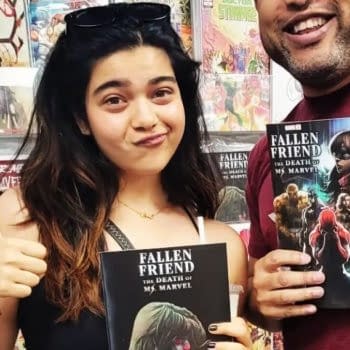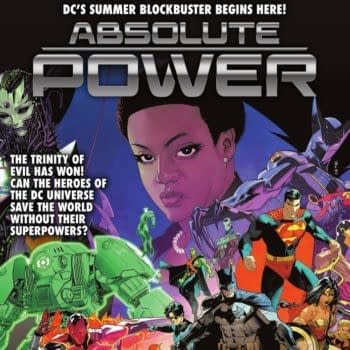Posted in: Comics, Recent Updates | Tagged:
"I Bloody Loved San Diego, Actually"
Photo by Molly McIsaac. Yes, folks, that's me being licked by Ben Templesmith in the wee hours one night at San Diego. It happens.
Yesterday, Heidi MacDonald posted a summary of her time at San Diego, with quotes from all sorts of people. And painted a rushed, panicked, malnourished, comicless, crowded San Diego Comic Con that, frankly I didn't recognise. Her theme is that, just as she found herself surviving on scraps of food through the show, so the comics industry is surviving on scraps left hanging around by the movie industry at a show that comics once owned. Oh and that there were lots of people handing out leaflets over the train tracks from the Con.
It's not exactly an uncommon observation, that movies have taken over Comic Con leaving no room for comics. But I think it's a false one.
I believe San Diego, more than any other show, is what you make it. There is no practical way to experience a tenth of the programming available and by picking and choosing you can define your Comic Con experience. As illustrator Christopher Higginson writes "I spent about 8hrs in comics classes at comic-con. & my friends respond with "you can take classes at comic-con?"" There is a greater amount and a greater diversity of comic-book based programming at San Diego than anywhere else in the English speaking world. You don't have to go to Ballroom 20 or Hall H if you don't want to. But you do have to look at the bumf they give you as you walk in, in favour of the large signs plastered over hotels.
And on the show floor, the biggest crowds may have been in the movie, TV and games sections. But the comics content was there and plentiful. Artists Alley, the Small Press tables, the Image Pavilion, so many comics publishers and creators giving their time and energy to meet… you. So what if more people are queuing for the No Ordinary Heroes car, that gives you more chance to be, well, licked by Ben Templesmith.
Larry Marder writes "I go to Comic-Con to meet fans & spread the word about Beanworld person-by-person. What I do after hours is fun but secondary. I had more fun at this Comic-Con than since the '80s. My little corner of it in Artist's Alley was small but oh so lively! A metric of Beanworld con traffic is how many FREE Beanworld Action Figures are taken. This Comic-Con was about 3 1/2 pounds–a new record!"
And just as it is impossible to do everything, it's impossible to report everything. Heidi says that it's easier to cover San Diego when you're not there. Which is true for the Comic Con announcements which are fed to various websites willing to play along and embargo until the show announcements happen, but by hanging around for the Q&A at the Vertigo panel even after the audio recordings ran out, I got a scoop denied everyone else. Just by being there. And another related one in the bar the night before. If a reporter allows themselves to just be pulled around by PR and Press teams then, yes, you might as well just look on Newsarama. But that doesn't have to be the case.
Ron Richards of iFanboy.com has my back. He writes;
I had a GREAT time at San Diego – and if you ask me, it was perfect for comics. Why?
1. The 2 big media things, Scott Pilgrim and Walking Dead, are based on CREATOR OWNED COMICS -how cool is that?
2. I've never seen such access to creators for fans. You could go to ANY publisher booth or artists alley and throw a rock and hit an amazing talented comics creator, or if you're nicer, just go talk to the
3. Last I checked, like 1/2 of the exhibit hall floor was filled with people selling comics and books and all sorts of comics related merchandise
4. Sure, Hall H was filled with media panels, but there were like a gazillion comics panels in the other rooms – I really think the comics programming outweighed the media programming
5. Personally, for me and the rest of the iFanboy guys, this was one of our best years – we got over 20 amazing interviews with creators, we had our best traffic month ever and I got to hang out with alot of friends and people who I respect in the comics industry who only gather in SD.
Heidi writes "But this year no one even pretended that comics were important". Which is so undeniably wrong. Did Hollywood, did studios, did the big money behave that way? Probably. But comics didn't. Comics definitely believed they were important. And that's all you need. Heidi, you should have been at the Milo Manara panel. Comics felt pretty important there – and at all the similar events impossible without Con.
Complaining about the movie people and the crowds they attract feels like a comic shop owner complaining about how many people go to the cinema at the end of the road rather than his comic shop. The huge success of one does not diminish the modest success of the other, unless you let it. In the comments, Heidi responds to me saying with a nice sarcastic;
Rich, as long as you avoid Hall H, Ballroom 20, the sidewalk in front of the convention center, the sidewalk in front of your hotel, the walk to dinner, the entire Gaslamp district, the t-shirts on the check-out girls at Ralphs, the bars after hours, the lettering on the trolley stop, the skies above and your bathroom mirror, it is perfectly possible to find nothing but comics at Comic-Con.
A lot of that is a negative sum game though. The lettering on the trolley stop you'd encounter whether it was in English or in Klingon. The walk to dinner is still a walk to dinner, whether there are zombies or not. Same the clothing of check-out girls – unless you're telling me that usually they wear no clothing, in which case I am definitely going to Ralph's earlier next year. But none of this diminishes the amount and quality of comic book creators, publishers, panelling and indeed actual bloody comics available. I bought a stack, many of which I'd never heard of and have been enjoying them thoroughly since. Did you see Finding Frank from Curio? If not, why not? Why interviewing movie directors when you could be talking to Sergio Aragones instead?
Charles Brownstein of the CBLDF writes at length for Bleeding Cool;
Every year I follow the commentary to come out of Comic-Con with great interest, and this year, as in years past, the commentary really does have a blind-man-and-the-elephant feel to it. This is really as it should be – Comic-Con has grown to be so vast that I think there isn't any one experience that fits all. I think Comic-Con really is what one makes of it, and it's important to not lose sight of what a dynamic comics show this year's Comic-Con was. From my point of view, Comic-Con remains the single best marketplace of ideas and goods, in that order, pertaining to comics in the United States, if not the world. As a celebration of comics in all its myriad forms, Comic-Con remains unsurpassed.
As a professional in charge of a leading non-profit organization I can say that the Comic Book Legal Defense Fund looks to Comic-Con as our most important fundraising event of the year. We meet hundreds and hundreds of supporters who manage to find us amidst the pop-culture wonderland of the exhibit floor. I can say that this year the folks I met coming up to the booth, or attending one of our Master Sessions, or our auction, or one of our parties, were almost uniformly having a great time. While I think everyone is feeling the pinch of the down economy, these folks were still giving what they could, still engaging in interesting discussions about our Free Speech work, and above all, making the most of their convention.
On the education side of things, I was fortunate to run a number of programs, including the CBLDF Master Sessions. We had standing room only for Paul Pope's inking seminar, and full houses for all the rest of them. I got to watch Rob Liefeld give a presentation on character design, where he was incredibly charming, and won everyone over by demonstrating the fundamentals of Deadpool's costume and saying "If I get to be 90 years old and I'm remembered as that guy who couldn't draw hands or feet, but could design a character that lasts, that's more than enough for me." I didn't host it, but I did get to see Jill Thompson create a flawless Beasts of Burden painting in just under two hours while explaining to the aspiring artists following along what each brushstroke meant. Terry Moore was hilarious when he was showing off his approach to using anatomy and expression as components of storytelling. And Darick Robertson's demonstration of his thought process in approaching characters was mesmerizing. It was really great to look out at those full house crowds and see people following along in their sketchbooks, asking their own questions about how the artists did what they did, and experience that sort of dialogue about craft. It's great that CCI can dedicate that kind of space to those sorts of programs. We're certainly grateful for it.
I think you get the Comic-Con you try to have. I'm the kind of person who likes to read about the craft of comics, likes to discover new artists, and likes to talk shop on the business and art sides of things. I got those things from this Comic-Con. I also love that if you're the kind of person who likes to watch superhero movies, or collect anime and manga, or follow the new wave of smart long-form television that there were plenty of those things there for you as well. I love that Milo Manara, Moto Hagio, Tom Neely, Geoff Johns, Lark Pien, Grant Morrison, Jaime Hernandez, Warren Ellis and Jill Thompson were all under the same roof as Helen Mirren, Ryan Reynolds, Kevin Smith, and tons of other Hollywood people I don't have much awareness of. Because that latter part isn't what I go to Comic-Con for, but I'm glad that it's there all the same.
Comic-Con International has a mission to provide education about comics and the popular arts. From what I can see they do that job bigger and better every year. Their education program has expanded from being a small and focused colloquium to being a massive university where one has to choose their own way. I think this is all for the best, and am very grateful to the organizers who work so hard to make this happen year after year. For as long as they keep giving us their A-game, we'll do our best to keep bringing ours.
So Heidi, you want a better San Diego Comic Con. Don't look to the organisers to create one – they already have. You just have to pick and choose the bits you want to experience and report on. Go to Ralph's early. And just put your head down and barge through the crowds in the way just as you would in any department store. You're a New Yorker, goddamit!
As Alison Baker of MonkeyBrain Books says "Anyone who doesn't have a fun at SDCC IS DOING IT WRONG"
And you know what? After spending tons of time and money on comics and with comics creators at the end of the Sunday I went to SingalongaBuffy to wind down. And I'm really glad it was there. Because you can enjoy comics and movie and game and toy stuff at Comic Con too. And that's also fine.
Van Jensen writes;
My personal highlight of what was a very fun show was listening to Rob Venditti in the not-yet-riotous Hyatt bar one evening as he explained watching Superman 2 as a child, and how the climax of the film was an almost religious experience as Superman revealed he still had his powers after all. It was a moment about the power of stories, and it spoke to a coexistence between comics and film that keeps getting lost in the annual Comic-Con comics vs. Hollywood discussion
Heidi writes that she's talking about the overall experience of Comic Con, but I'd argue there's no such definite article. It's only her overall experience – and that is one she picked and chose from the materials available. And there are more comic book materials, from big corporate to small self published, at San Diego in one week than anywhere else in the USA, if only you will focus your eyes to see them.
And don't let some Hollywood person stab you in one of them with a True Blood-labelled pen.












